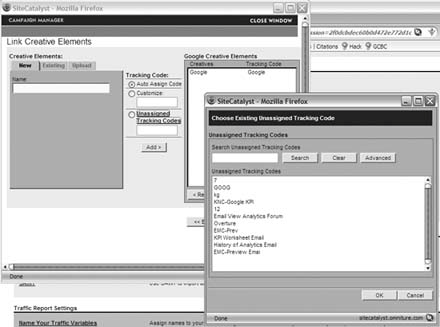Hack40.Measure Banner Advertising
Hack 40. Measure Banner Advertising
Knowing the impressions, response, success, and cost for each of your banner advertising campaigns can significantly improve the return on investment associated with this popular form of advertising. Capable of reaching several hundred million people worldwide, banner ads have emerged as an essential tool for web marketers. As such, it is critical that you understand how best to measure banner advertising effectiveness and how to use this measurement to improve your business. To evaluate the effectiveness of any banner ad, there are three fundamental measurements: impressions, response, and conversion. 3.5.1. ImpressionsBanner impressions are typically reported by an ad server solution, based on the number of image requests it receives. Impressions are usually broken out by the name of each creative element, but not necessarily by placement or timeframe. This can become a challenge if you run the same creative across multiple web sites and/or multiple periods. In this case, be sure to assign unique codes for each dimension you want to analyzecreative, web site placement, and timeframe (see Table 3-3). It is important to identify and carefully set these dimensions when you're making the placement. Backing into these dimensions can be difficult, time consuming, or impossible, depending on which web measurement system you use.
3.5.2. ResponseThe measurement of response to a banner ad click is usually automatic in web measurement applications, provided you've told the application what to look for. Most vendors will want you to use either a standard identifier in the "click" URL or tell the system via some setup what to look for and what each of the variables maps to (Figure 3-3). For example, you may use a URL like the following to identify campaigns: http://www.oreilly.com/index.html?campaign=banner1&message=buynow Figure 3-3. Identifying campaigns When a user clicks to the web site with this link, the web measurement platform parses the URL, looks for thecampaign=banner1 name=value pair, and if present, drops the campaign identifier in the user's cookie. When this happens, a "click" is recorded. But there is an added benefit. When the campaign identifier is added to the user's cookie, the application can now tie this to any subsequent action you are tracking with the platform.
The essence of measuring response is: make sure you correctly code each and every link you're using for your banner campaign. Any clicks that don't have the proper codes will not be recorded, and you're unlikely to be able to back and reconstruct those clicks. Get it right the first time, and you'll minimize frustration down the line. As always, if you have questions about exactly how to measure banner response, contact your vendor. 3.5.3. ConversionConversion events [Hack #39] are activities visitors engage in that have some inherent value to your organization. Purchase a product, book a flight, request more information, visit your web sitethese are all conversion events. However, a word of caution: just because you've identified these events, it doesn't necessarily mean you can tie an event to your banner ad. Again, you want to make sure that you've defined conversion events correctly in your measurement application so they'll be tied to your banner ad response. In the end, you should be able to generate a report that tells you (ideally) how many impressions each banner received, how many responses each generated, and how many conversions resulted (Figure 3-4). The best systems will then allow you to drill down into this information, exploring how individual dimensions (Table 3-3) performed and which conversion events each banner was most successful at driving. You may need to integrate data [Hack #32] to bring your impression data into the system, but if you use a unique identifier for each banner, this is actually less difficult than you'd think. 3.5.4. The Measurements You Need to MakeOnce you've nailed down impressions, response, and conversion, you can calculate key performance indicators and improve your business (Figure 3-4). Figure 3-4. Key measurements for banner ads 3.5.4.1 Click-through rate (CTR).Calculated as total direct response divided by total impressions, the click-through rate tells you how effectively your banner ads elicit response. While industry average click-through rates are available, you're better off comparing your banner ads to one other [Hack #93]. Remember, poor click-through rates can be an early warning that your banner ispoorly targeted or the call-to-action is unclear. Occasionally, exceptionally high CTR can mean unfiltered spider activity [Hack #23], which, if unchecked, can dramatically lower the conversion rate for the campaign. 3.5.4.2 Click-to-conversion rate (CTC).Calculated as total conversions divided by total response, the click-to-conversion rate provides insight into how well you are driving business success. High click-through rates and low click-to-conversion can indicate poorly designed landing pages or significant leaks in the conversion processtrouble spots that should be addressed immediately. 3.5.4.3 Cost per acquisition (CPA).Calculated as total conversions divided by total costs, cost per acquisition will indicate your average cost of customer acquisition for each banner ad. While this is a valuable metric to compare across different acquisition programs, it is most valuable when compared to revenue per customer, profit per customer, or lifetime value per customer. Obviously, any campaigns that cost more than the revenue they produce should be carefully scrutinized and perhaps discontinued. 3.5.5. Measuring Banner Advertising: A ChecklistTo simplify the process, here is a checklist of things you need to do and things you should do when you set up a banner advertising campaign (Table 3-4).
In the end, if you follow this checklist and make the recommended measurements, you should be able to improve your banner campaigns with ease. The basic logic is "keep what works and cut the rest," and since you'll have great visibility, this will be a breeze. Matt Belkin and Eric T. Peterson |
EAN: 2147483647
Pages: 157
